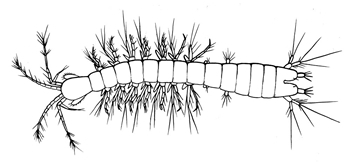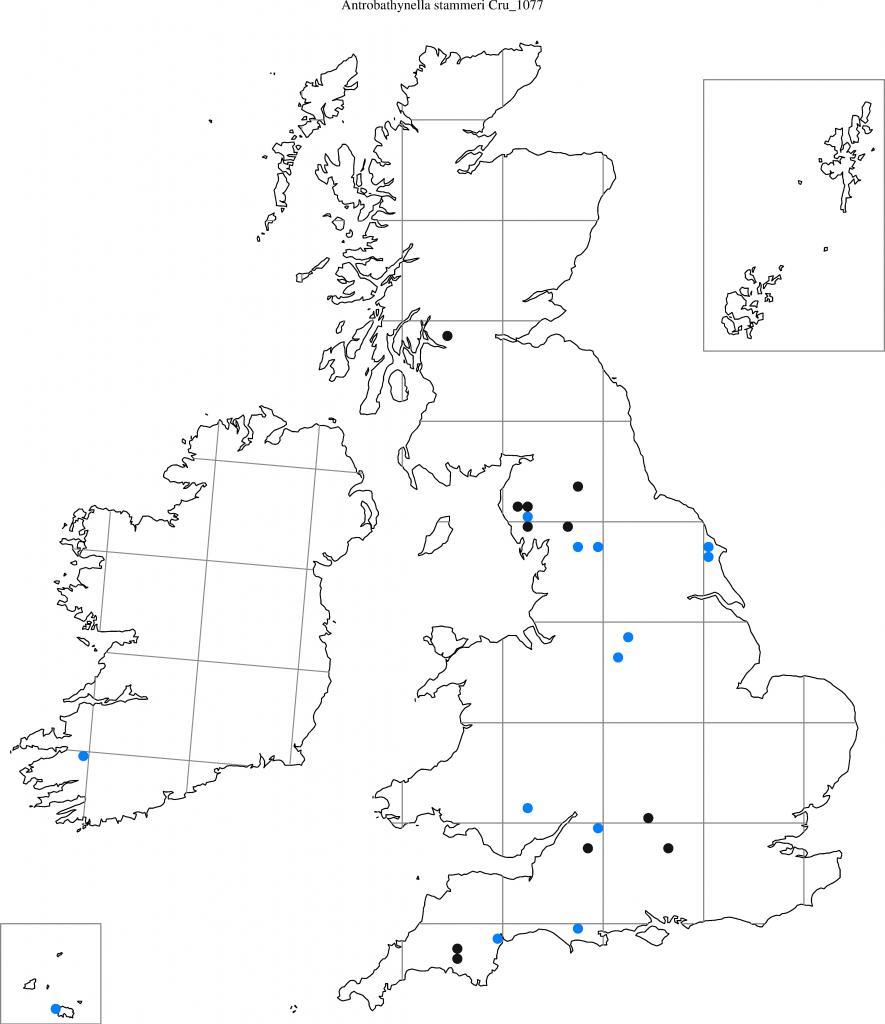
(drawing from Gledhill et.al. 1993, after Thienemann)
As discussed in the section on hypogean Crustacea ecology, it is now widely believed that only Antrobathynella stammeri exists in Britain and Ireland. However, future work might find that Bathynella natans does occur in the British Isles and subsequently the early records of Bathynella natans cannot be entirely discounted.
Both Antrobathynella stammeri and Bathynella natans are very small, eyeless crustaceans, approximately 1mm long and 0.1mm in diameter. They are more or less colourless with long, thin bodies, highly developed to suit the interstitial habitat in which they are generally recorded. The body is elongate with 14 trunk segments (8 thoracic and 6 abdominal) and the head is longer than broad. Each of the thoracic limbs, with the exception of the last, is two-branched. All but the first and last abdominal segments are without appendages. The 1st antenna is un-branched, the 2nd has a small branch. The two species are separated by the number of spines (5 – 7 in Bathynella and 4 in Antrobathynella) on the uropodal protopod and the number of teeth (7 in Bathynella and 6 in Antrobathynella) on the mandible.
Bathynellids were first recorded in Britain in 1927, when A.G. Lowndes collected two specimens (recorded as Bathynella natans) from a tub which caught drippings from the roof of one of the tunnels in Pickwick Quarry, one of the bath stone quarries near Corsham, Wiltshire. Bathynella natans has since been recorded from a spring and riverine gravels in Devon; a spring-fed cattle trough in Berkshire; and water pumped from alluvial gravels on the Thames near Pangbourne, Oxfordshire. This first group of early records were all listed as Bathynella natans and although material was not available for confirmation it is thought that they were probably mis-identified Antrobathynella, although without confirmation, the existence of Bathynella natans in Britain cannot be entirely discounted. All modern (post 1960) records have been positively identified as Antrobathynella stammeri and include: boreholes in Yorkshire and Devon; pools and streams in White Scar, Skoska and Great Douk caves (Yorkshire); riverine gravels on the rivers Plym (Devon), Tees, Lune, Liza, Derwent, Duddon (Cumbria), Skirfare (Yorkshire) and Lathkill (Derbyshire); and alluvial gravels on the Altquhurbum Burn, a tributary of the River Endrick in Stirlingshire, Scotland. The species was recently (2012) recorded from the Ogof Draenen cave system in South Wales and is also known from the interstitial habitat on the River Flesk in Killarney, the only record from Ireland. Outside of Britain Antrobathynella stammeri is known from Germany, Austria, Italy, Romania and the Czech Republic and was recently discovered on the island of Jersey.
Most of the records are from the interstitial habitat and include areas previously glaciated. Bathynella / Antrobathynella is likely to have survived beneath the ice in sub-glacial refugia. Bathynellidae are probably widespread in the interstitial of the phreatic or permanent water table. The recorded distribution in the British Isles is wide but disjunct and it is likely that the bathynellids have been overlooked and under-recorded.
Electron micrograph of Antrobathynella stammeri (photo courtesy of Jules Carter)
